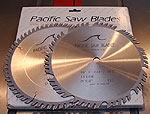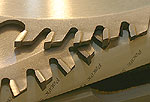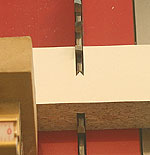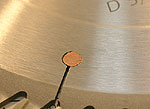This is a Veteran Owned site
![]()
 |
They may be the new kid on the table saw blade block but the products Pacific Saw Blades offers rival the traditional good old boys. Click image to enlarge |
Pacific Saw Blades
New company, solid technology & value
Text & photos by Tom Hintz
Pacific Saw Blades is new to the woodworking landscape but seems to have done their homework on manufacturing quality blades for woodworking. Based in Seattle, WA, their blades carry the “Made In Thailand” stamp, something that is increasingly common as the manufacturing capabilities of the East grow increasingly high end.
Initial Impressions
Two 10”-diameter Pacific Saw Blades were used for this evaluation. Their (#10-15CMB-50) 50-tooth combination and (#10-ATB25-60) 60-tooth Precision Trim blades were chosen as they are the most common cut blade styles used in the typical woodworking shop.
 |
The teeth on Pacific Saw Blades products are heavy-duty, finely ground and the brazing looks first rate. Click image to enlarge |
Both blades appear very well made with clean laser-cut bodies (including anti-vibration/expansion slots) and clean, consistent brazing at the carbide teeth. The teeth have lots of bulk that should allow re-sharpening several times. Also, the grinding on the teeth is clean, consistent and precise.
Both blade bodies are made from high-end German steel and fitted with teeth ground from HC-10 carbide, an exceptionally tough compound that should resist the wear of woodworking very well.
The center holes in both blades fit the arbor very closely, an important feature of a table saw blade. A close-fitting arbor hole prevents the blade running out of round vertically, something that can compromise cut quality and initiate vibrations.
Both blades have 0.085”-thick bodies and a physical kerf width of 0.131”. Measuring the actual kerf produced in the wood showed very little variation in width, indicating the teeth are precisely aligned and ground.
While both blade styles feature variations of the common ATB (Alternate Tooth Bevel) design, they do differ in the angles used. The combination blade has a 15-degree top bevel and hook angle for the best cut in a wide range of materials and cut directions. The Precision Trim blade has a 25-degree top bevel angle (10-degree hook) to maximize the slicing properties that help produce ultra clean cuts in fragile veneer and laminate materials.
The Precision Trim blade has expansion slots cut, apparently with a laser. While these cuts are relatively common in modern blades, the copper insert in the circular termination of each slot is not. This insert goes a step further towards reducing blade noise.
Test Preparation
 |
Before checking the blades themselves, saw alignments were confirmed to be sure they would not influence the results. Then, the blades were checked closely and found to have as close of zero runout as I have seen. Click image to enlarge |
Before evaluating saw blades, I check the saw itself thoroughly to be sure it is perfectly aligned. Starting at the bare arbor, my SuperBar/MasterPlate system was used to verify the alignments that could influence the measurements taken on the blades.
I also check the fence and miter guide to be sure they are perfectly aligned as if either is wrong, they can degrade the quality of the cut and make a good blade look bad.
Finally, the saw table and fence surfaces were given a fresh coat of wax. I want to be sure that resistance felt during cutting was coming from the blade and not a sticky saw surface.
Runout
With everything checked and dialed in, the Pacific Saw Blades were installed and checked for runout. The maximum found was 0.003”, measured just below the gullets. Considering that measuring runout this far out on the blade magnifies even tiny errors anywhere from the arbor on out, this level of runout can be considered perfect.
To be sure of the measurement, the blades were turned 90-degrees on the arbor, tightened and checked again. Though this re-check was done at three positions on each blade, maximum runout remained 0.003”.
In the Shop
 |
 |
The cuts produced by the Combination blade (left) and Precision Trim blade (right) were first rate throughout the evaluation. The Combination blade was subjected to very heavy use, handling all of the cutting for a large hickory cabinet project. It cut as well at the end of that job as in the beginning. Click images to enlarge |
|
Regardless of how nice a blade looks or how lofty the manufacturers claims, it is how it cuts wood that is of most interest to the woodworker. Though I fed a wide range of wood species across both Pacific Saw Blades, they handled all with ease. In fact, the combination blade was exclusively for an all hickory cabinet project I had in the shop. If you have worked with hickory, you know this amounts to a full-on stress test. The Pacific Saw Blade passed with flying colors, and made very clean, chip-free cuts from beginning to end.
 |
The Precision Trim blade uses steep angles on the teeth to slice rather than tear even fragile fibers or, in this case, cheap laminate. Click image to enlarge |
One of the first things I noticed about the Pacific Saw Blades is that they are quiet-running both when spinning free and actually engaged in the wood. The hiss of the teeth is minor and inescapable. However, there was no “ringing” or other noise noticed while making cuts. In addition, neither blade produced any vibration in the saw.
Both blade styles sliced through all of the stock tried easily, requiring minimal feed pressure. During test rips with the combination blade (made with a jointed edge against the fence) there was no tendency for the stock to turn or wander during the cut. When cutting relatively thin stock, down to ¼”-thick, there was virtually no lifting of the wood by either blade. The ease with which these blades cut produced no tendency for the stock to “walk” along a miter gauge fence during even 45-degree cuts.
In the course of building the cabinet, the combination blade was used for all cross, rip and miter cuts in the hickory stock. It handles all very well, leaving clean, splinter-free edges. In fact, the cuts were so clean; I used the sawn edges as they came from the saw for panel glue ups to make the sides and top. All of those panels came out with nearly invisible joints.
Along the way I also cut some pine, polar, oak and laminate-covered stock with the Pacific Saw Blades producing very clean cuts in all of them.
 |
In addition to the common laser-cut relief's, Pacific saw Blades adds this copper insert that further reduces sound levels generated during use. Click image to enlarge |
The Precision Trim blade was tested primarily in the crosscut mode but I also did some rips in veneer and laminate stock. In all cases, the Precision Trim blade produced exceptionally clean cut surfaces and chip-free edges. Even cheap laminate cut without chipping or splitting. As a final test, I ripped a length of Lauan plywood and found a remarkably clean edge in this nearly impossible-to-cut material.
Throughout the evaluation there was no loss of sharpness noticed in either blade. This is particularly remarkable with the combination blade considering it was used extensively to cut the hickory for the cabinet project. The Precision Trim blade was used somewhat less but that percentage of use mimics normal woodshop usage. It also remained sharp with no degradation of cut quality noted.
Conclusions
 |
Taken after the evaluation was complete, this photo shows no visible signs of wear and surprisingly little buildup of pitch and other wood contaminates we normally see. Click image to enlarge |
The Pacific Saw Blades look great as they come from the box. The same can be said about the manufacturing and design. However, their performance on the saw provided the clearest indication of how good they really are. Both styles tested performed great, making clean, effortless cuts in some of the toughest wood I have worked with.
Pacific Saw Blade may be new to the woodworking scene but they produce blades with a quality rivaling the old-timers. Their prices may be doing better than that. The Combination blade tested here currently (7-6-2006) sells for $58.50 and the Precision Trim model for $68.00. These are listed as “introductory” prices so you might want to hurry.
Currently, Pacific Saw Blades are available through their web site. We have included a link to that site below.
Note: The Pacific Saw Blade’s will remain the primary ones used on my table saw to see how they hold up over the long run. If the testing done so far (and it was considerably more than normal because of the hickory project) is any indication, we have along way to go before the Pacific Saw Blades are ready for sharpening.
Visit the Pacific Saw Blades web site for more info or to purchase their products.
Do you have a comment on this review? –Email Me!
All written, photographic and drawn materials are property of and copyright by NewWoodworker.com LLC 2000-2019. Materials may not be used in any way without the written permission of the owner.
